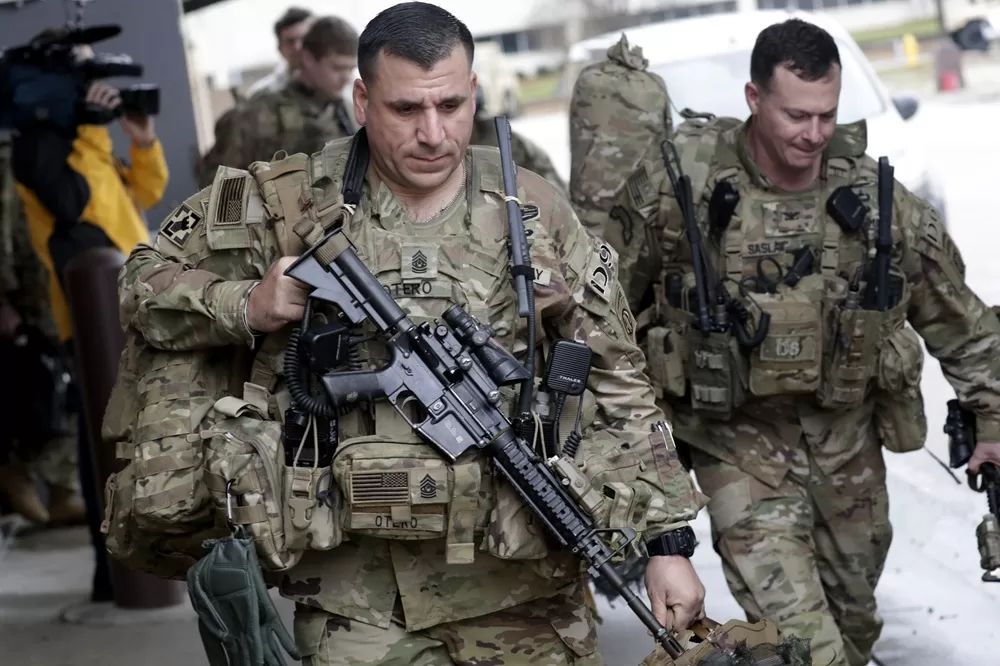Doha (Oct 24) – Thousands of American soldiers face a direct threat of attack from Iran if US President Donald Trump decides to join Israel in strikes against Iran. Trump stated on Wednesday that such action is a possibility, though not a certainty.
According to security experts, if US forces are ordered to directly participate in Israeli airstrikes, Iran would retaliate swiftly, potentially targeting American bases across numerous Middle Eastern countries. Experts also warned that many US soldiers would have only minutes to take cover if long-range missiles were launched from Iran.
“If the United States intervenes militarily in the region, the resulting damage will be difficult to erase,” said Iran’s Supreme Leader Ayatollah Ali Khamenei, as quoted by Iranian state media.
40,000 Troops in Harm’s Way
More than 40,000 US troops and Pentagon civilian personnel are currently deployed in the Middle East. Billions of dollars worth of military hardware and equipment are also stored in the region.
Dana Stroul, who served as the Pentagon’s top official for Middle East policy during the Biden administration, stated that US forces have spent decades strengthening the region’s defenses during both wartime and peacetime. She added that these defenses were further bolstered after the Hamas attack on Israel in October 2023, which led to conflicts between Israel and Iran’s regional allies.
“US forces have fully prepared the battlefield should the Iranian government decide to target US forces or activate its regional militias,” Ms. Stroul said. She also noted that the escalation of tensions in the coming days will depend on the extent of US participation in Israeli offensive operations.
Risks to US Bases in the Region
Hundreds to several thousand US troops are stationed in other regional countries, such as Jordan, Syria, and Oman, at bases operated by those governments. An exact number hasn’t been publicly released, as the Trump administration plans to reduce troop presence in some of these countries, especially Syria.
Adel Abdel Ghafar, a senior analyst at the Middle East Council on Global Affairs in Doha, Qatar, said that US forces in Iraq, Bahrain, and Kuwait would be Iran’s primary targets if war breaks out. Non-essential staff and their families have already been evacuated from US embassies in these countries.
Mr. Abdel Ghafar stated that Iran-backed militias in Iraq and other countries pose a significant threat to US military and diplomatic facilities. He also mentioned that a long-range missile launched from within Iran could reach bases in Gulf countries in approximately 3-4 minutes.
“This means air defenses would have very little time to intercept incoming missiles,” he said. “If it happens, it will be a disaster.”
Here are the countries where US troops face significant risk:
Iraq
Approximately 2,500 US troops and contractors are located in Iraq, specifically in Baghdad, the northern Kurdish region, and the western desert. The Al Asad airbase — managed by the Iraqi government — was attacked earlier this week by Iranian-backed Shia groups using drones. US forces there successfully shot down these missiles.
Although relations between Washington and Baghdad have been strained since the US troop withdrawal in 2011, years later, US forces were welcomed back to combat ISIS. In 2020, the US killed General Qasem Soleimani — commander of Iran’s Quds Force — in an airstrike as he arrived in Baghdad to meet with the Iraqi Prime Minister. That attack escalated tensions between Tehran and Washington.
Bahrain
The US Navy’s Fifth Fleet is headquartered in Manama, Bahrain. Around 9,000 US military and civilian personnel are stationed there.
This command is responsible for protecting commercial vessels passing through the Strait of Hormuz, a critical waterway for 20% of the world’s oil supply. Iran has threatened to deploy up to 6,000 naval mines there, which could endanger US vessels and oil supplies to countries like Saudi Arabia, the UAE, China, and India.
Kuwait
Approximately 13,500 US troops are deployed across five military bases in Kuwait, which have served for decades as a staging ground for US operations worldwide. Military ties between Kuwait and the US have been strong since the 1991 Gulf War, when the US led a coalition to liberate Kuwait after Iraq’s invasion a year prior. In 2003, the US used Kuwait as a base for the invasion of Iraq, which led to the overthrow of Saddam Hussein.
Qatar
Al Udeid Air Base in Qatar is the largest US facility in the Middle East, housing around 10,000 troops. It serves as the headquarters for the U.S. Central Command in the region.
This base has been used for attacks against the Taliban and Al-Qaeda after the September 11, 2001, attacks. During the wars in Iraq and Afghanistan and the ISIS bombing campaigns in Syria, Al Udeid became a central hub for air operations. Fighter jets, bombers, drones, and aerial refuelers have operated from there. It also served as the evacuation hub for tens of thousands of Afghans and Americans in 2021 during the US withdrawal from Afghanistan.
United Arab Emirates
Around 3,500 US troops are stationed at Al Dhafra Air Base, located outside Abu Dhabi. US F-22 fighter jets have been deployed there multiple times to protect Emirati oil tankers, which were attacked by Houthi fighters linked to Iran in 2022. The 380th Air Expeditionary Wing of the US Air Force is based there. It conducts offensive operations against ISIS and Houthis, as well as intelligence and surveillance missions related to the wars in Afghanistan and Iraq.



